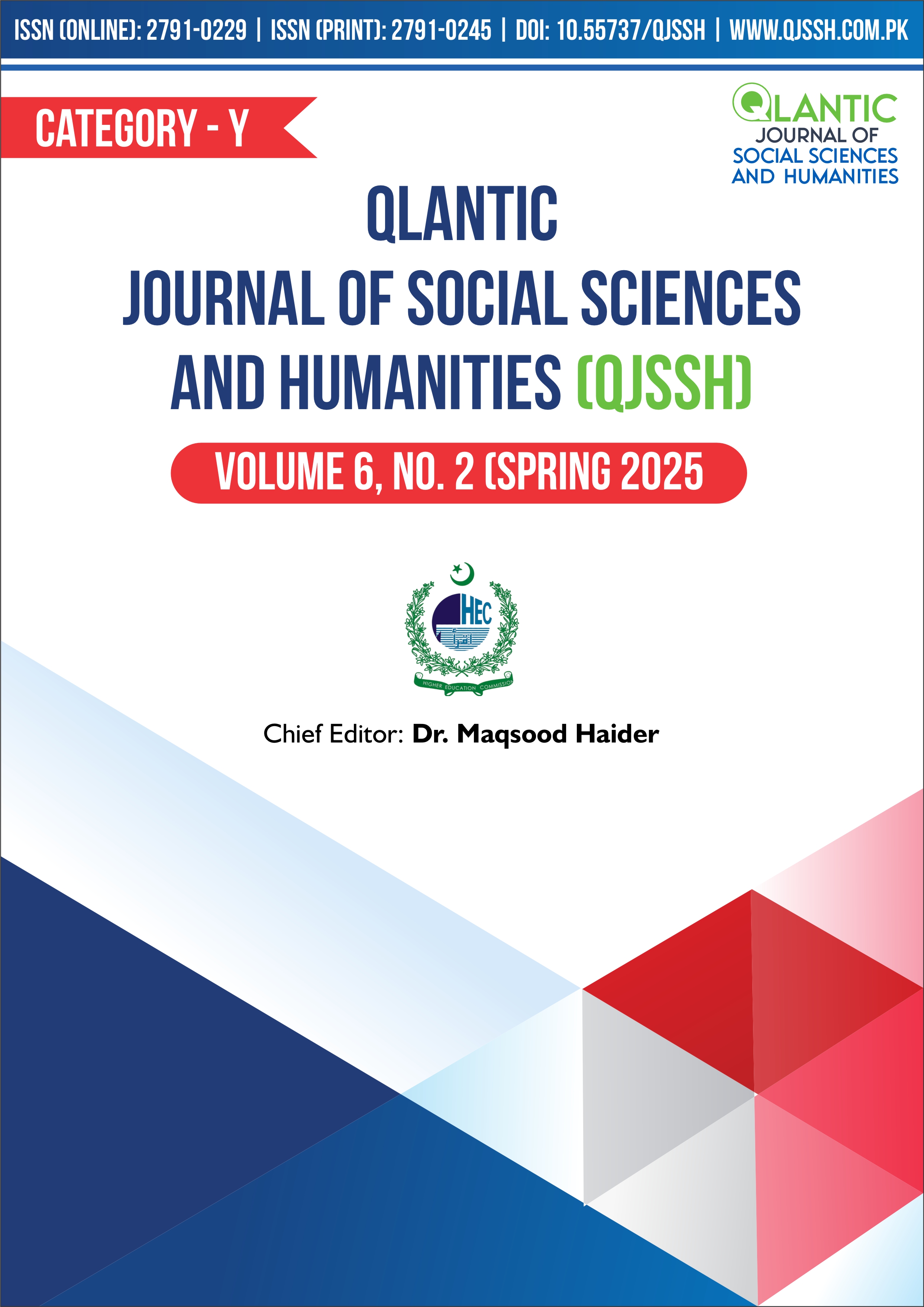Safety Culture and Its Underlying Dimensions: Emergency Services Personal Perspective
DOI:
https://doi.org/10.55737/qjssh.vi-ii.25354Keywords:
Safety Culture, Injuries, Thematic Analysis, Rescue 1122Abstract
Poor workplace safety is causing approximately 2.78 million casualties daily, which leads to a considerable burden of workplace injuries/ diseases costing approximately 4% of the annual GDP of the world (ILO, 2020). To explore the perspective and underlying dimensions of the safety culture of Emergency Services Personnel (Rescue 1122), the present investigation was conducted from 10-5-2023 to 9-5-2024 in the city of Lahore, Punjab. A purposive sample of 12 Participants (9 men and 3 women, including 3 managers, 3 trainers, 3 middle managers, and 3 participants) who had been serving the department for at least 3 years and had a maximum experience of 15 years was obtained. Inductive and deductive approaches were used to discover safety culture and its underlying dimensions based on focus group findings. Semi-structured interviews were conducted for a duration of 45 to 70 minutes, followed by thematic analysis. Major identified themes of safety culture were: safety management, safety environment, safety insights, safety behavior & consequences, and safety participation, along with other sub-dimensions, two new factors (safety behavior & consequences and safety participation) will be a value addition. Management domain comprised of facets like management commitment, leadership, supervision, and organization support. Safety environment domain facets were safety training, equipment availability, safety rules & regulations, communication channels, work schedule, and safety crew. The facets of safety insights and behavior were safety knowledge, safety motivation, safety learning attitude, risk awareness, safety audit, accident reporting, and safety violations reporting mechanism.
References
Ahadzi, D. F., Afitiri, A., & Ahadzi, E. (2021). Organizational safety culture perceptions of healthcare workers in Ghana: A cross-sectional interview study. International Journal of Nursing Studies Advances, 3, 100020. https://doi.org/10.1016/j.ijnsa.2021.100020
Ajzen, I. (1987). Attitudes, Traits, and Actions: Dispositional Prediction of Behavior in Personality and Social Psychology. Advances in Experimental Social Psychology, 1–63. https://doi.org/10.1016/s0065-2601(08)60411-6
Al-Bayati, A. J., et al. (2017). Impact of construction safety culture and construction safety climate on safety behavior and safety motivation. Journal of Construction Engineering and Management, 143(3). https://doi.org/10.1061/(ASCE)CO.1943-7862.0001245
Ali, H., Abdullah, N. A. C., & Subramaniam, C. (2009). Management practice in safety culture and its influence on workplace injury: An industrial study in Malaysia. Disaster Prevention and Management: An International Journal, 18(5), 470-477. https://doi.org/10.1108/09653560911003660
Alli, B. O., & International Labour Office. (2008). Fundamental principles of occupational health and safety. International Labour Office.
Amponsah-Tawiah, K., & Mensah, J. (2016). Occupational Health and Safety and Organizational Commitment: Evidence from the Ghanaian Mining Industry. Safety and Health at Work, 7(3), 225–230. https://doi.org/10.1016/j.shaw.2016.01.002
Baram, M. (2009). Biotechnological research on the most dangerous pathogens: Challenges for risk governance and safety management. Safety Science, 47(6), 890–898. https://doi.org/10.1016/j.ssci.2008.10.010
Bhattacharya, Y. (2015). Measuring Safety Culture on Ships Using Safety Climate: A Study among Indian Officers. International Journal of e-Navigation and Maritime Economy, 3, 51–70. https://doi.org/10.1016/j.enavi.2015.12.006
Bowling, N. A., Alarcon, G. M., Bragg, C. B., & Hartman, M. J. (2015). A meta-analytic examination of the potential correlates and consequences of workload. Work & Stress, 29(2), 95–113. https://doi.org/10.1080/02678373.2015.1033037
Braun, V., & Clarke, V. (2006). Using thematic analysis in psychology. Qualitative Research in Psychology, 3(2), 77–101. https://doi.org/10.1191/1478088706qp063oa
Choudhry, R. M., Fang, D., & Mohamed, S. (2007). Developing a model of construction safety culture. Journal of management in engineering, 23(4), 207-212. https://doi.org/10.1061/(ASCE)0742-597X(2007)23:4(207)
Cox, S., & Cox, T. (1991). The structure of employee attitudes to safety: A European example. Work & stress, 5(2), 93-106. https://doi.org/10.1080/02678379108257007
Fang, D., & Wu, H. (2013). Development of a Safety Culture Interaction (SCI) model for construction projects. Safety Science, 57, 138–149. https://doi.org/10.1016/j.ssci.2013.02.003
Goetsch, D.L., (2010). Occupational Safety and Health. Pearson India
Hald, K. S. (2018). Social influence and safe behavior in manufacturing. Safety science, 109, 1-11. https://doi.org/10.1016/j.ssci.2018.05.008
Huang, Y. H., Verma, S. K., Chang, W. R., Courtney, T. K., Lombardi, D. A., Brennan, M. J., & Perry, M. J. (2012). Supervisor vs. employee safety perceptions and association with future injury in US limited-service restaurant workers. Accident Analysis & Prevention, 47, 45–51. https://doi.org/10.1016/j.aap.2011.11.023
International Labour Organization. (2020). International Labour Organization. Ilo.org. https://www.ilo.org/global/lang--en/index.htm
Kalteh, H. O., Salesi, M., Cousins, R., &Mokarami, H. (2020). Assessing safety culture in a gas refinery complex: Development of a tool using a sociotechnical work systems and macroergonomics approach. Safety Science, 132, 104969. https://doi.org/10.1016/j.ssci.2020.104969
Kaplan, S., & Tetrick, L. E. (2011). Workplace safety and accidents: An industrial and organizational psychology perspective. APA handbook of industrial and organizational psychology, Vol 1: Building and developing the organization, 455-472. https://doi.org/10.1037/12169-014
Kim, Y., Park, J., & Park, M. (2016). Creating a Culture of Prevention in Occupational Safety and Health Practice. Safety and Health at Work, 7(2), 89–96. https://doi.org/10.1016/j.shaw.2016.02.002
Kobayashi, E., & Kerbo, H. R. (2012). Differences in Perceived Levels of Informal Punishments for Non-compliance and Rewards for Compliance: A Comparison of Japanese and American Workers. Deviant Behavior, 33(1), 40–57. https://doi.org/10.1080/01639625.2010.538363
Matisoff, B. (1997). Occupational Safety and Health Programs. Handbook of Electronics Manufacturing Engineering, 478–506. https://doi.org/10.1007/978-1-4615-6047-0_16
Mearns, K. J., & Flin, R. (1999). Assessing the state of organizational safety—culture or climate? Current Psychology, 18(1), 5-17. https://doi.org/10.1007/s12144-999-1013-3
Mohamed, S. (2003). Scorecard approach to benchmarking organizational safety culture in construction. Journal of Construction Engineering and Management, 129(1), 80-88. https://doi.org/10.1061/(asce)0733-9364(2003)129:1(80)
Momani, A., Hirzallah, M., & Mumani, A. (2017). Improving employees' safety awareness in healthcare organizations using the DMAIC quality improvement approach. Journal for Healthcare Quality, 39(1), 54-63. https://doi.org/10.1097/jhq.0000000000000049
Mozola, J., Gadas, P., Hrazdil, V., & Radková, P. (2017). Anatase, brookite and rutile from pegmatite near Bobrůvka, Strážek Moldanubicum (Bohemian Massif, Czech Republic). Bulletin Mineralogie Petrologie, 25(1), 3-11. https://www.bullmineral.cz/paper/70
Petitta, L., Probst, T. M., Barbaranelli, C., & Ghezzi, V. (2017). Disentangling the roles of safety climate and safety culture: Multi-level effects on the relationship between supervisor enforcement and safety compliance. Accident Analysis & Prevention, 99, 77-89. https://doi.org/10.1016/j.aap.2016.11.012
Qureshi, M. I., Iftikhar, M., Abbas, S. G., Hassan, U., Khan, K., & Zaman, K. (2013). Relationship between job stress, workload, environment and employees turnover intentions: What we know, what should we know. World Applied Sciences Journal, 23(6), 764-770. https://doi.org/10.5829/idosi.wasj.2013.23.06.313
Razzak, J. A., Hyder, A. A., Akhtar, T., Khan, M., & Khan, U. R. (2008). Assessing emergency medical care in low-income countries: A pilot study from Pakistan. BMC Emergency Medicine, 8(1). https://doi.org/10.1186/1471-227x-8-8
Sabbarwal, S., Singh, M. M., & Amiri, M. (2017, July 1). Occupational stress on employees in information technology organizations. https://papers.ssrn.com/sol3/papers.cfm?abstract_id=4886274
Saenko, V., Ivanov, V., Tsyb, A., Bogdanova, T., Tronko, M., Demidchik, Y., & Yamashita, S. (2011). The Chernobyl accident and its consequences. Clinical Oncology, 23(4), 234-243. https://doi.org/10.1016/j.clon.2011.01.502
Samaranayake, A. I., Nishadya, S., & Jayasundara, U. K. (2022). Analyzing Safety Culture in Sri Lankan Industrial Chemical Laboratories. Safety and Health at Work, 13(1), 86–92. https://doi.org/10.1016/j.shaw.2021.11.001
Schröder, I., Huang, D. Y. Q., Ellis, O., Gibson, J. H., & Wayne, N. L. (2016). Laboratory safety attitudes and practices: A comparison of academic, government, and industry researchers. Journal of Chemical Health &Amp; Safety, 23(1), 12–23. https://doi.org/10.1016/j.jchas.2015.03.001
Singh, A., & Misra, S. C. (2020). A Dominance based Rough Set analysis for investigating employee perception of safety at workplace and safety compliance. Safety Science, 127, 104702. https://doi.org/10.1016/j.ssci.2020.104702
Swuste, P., Groeneweg, J., Van Gulijk, C., Zwaard, W., Lemkowitz, S., & Oostendorp, Y. (2020). The future of safety science. Safety science, 125, 104593. https://doi.org/10.1016/j.ssci.2019.104593
Vilkman, E. (1999). Voice Problems at work: a challenge for occupational safety and health arrangement. Folia Phoniatrica Et Logopaedica, 52(1–3), 120–125. https://doi.org/10.1159/000021519
Xu, G., Wang, X., Wang, R., Yano, G., & Zou, R. (2021). Anti-corruption, safety compliance and coal mine deaths: Evidence from China. Journal of Economic Behavior & Organization, 188, 458–488. https://doi.org/10.1016/j.jebo.2021.05.013
Zhang, B., Chu, Z., Cheng, L., & Zou, N. (2019). A quantitative safety regulation compliance level evaluation method. Safety Science, 112, 81–89. https://doi.org/10.1016/j.ssci.2018.10.016
Zin, S. M., & Ismail, F. (2012). Employers’ Behavioral Safety Compliance Factors toward Occupational, Safety and Health Improvement in the Construction Industry. Procedia - Social and Behavioral Sciences, 36, 742–751. https://doi.org/10.1016/j.sbspro.2012.03.081
Downloads
Published
Issue
Section
License

This work is licensed under a Creative Commons Attribution-NonCommercial 4.0 International License.





